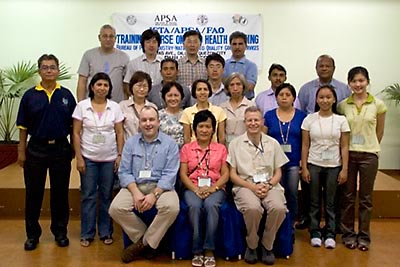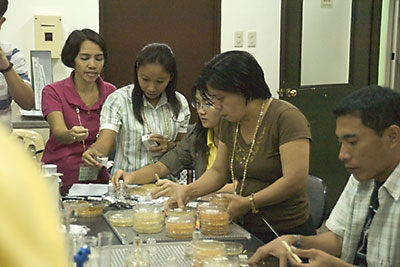Seed health testing in the Philippines
By Steve Roberts, 04 Mar 2007
Following a previous successful training course in the Asia-Pacific region in Bangkok in July 2006, this was the second ISTA/APSA seed health training course to be held in South East Asia. This time there was additional sponsorship from FAO, which meant that participants only had to pay for their travel expenses. The course aimed to provide participants with the skills and knowledge needed to improve the standardisation and reliability of seed health testing in the Asia-Pacific Region; participants got hands-on experience of performing seed tests for fungi, bacteria and viruses, with an emphasis on methods in the ISTA rules. Representing ISTA, the training was led by Dr Steve Roberts of Plant Health Solutions, UK (www.planthealth.co.uk), with excellent support from Dr Rick Mumford of CSL, UK, and local organiser Ms Jane Bartolini. The course was hosted by the Philippine National Seed Quality Control Services (NSQCS) at their central laboratories in Quezon City, Manila. NSQCS is part of the Bureau of Plant Industry (BPI) and Quezon City, as the former capital, also houses the buildings of many other Philippine government departments. Participants were invited from both government laboratories and private seed companies in the Asian-Pacific region, with preference given to APSA and ISTA members. Eighteen participants attended, representing ten countries: Afghanistan, Bangladesh, Egypt, China (Hong Kong), Korea, Malaysia, Sri Lanka, Taiwan, Thailand and of course the host country the Philippines. There was considerable variation in the backgrounds and level of experience amongst the trainees, who ranged from young laboratory technicians to (older) company directors. Following a formal welcome from BPI Director Mr. Joel S. Rudinas and messages from ISTA (Dr Steve Roberts) and APSA (Dr Frisco Malabanan), the intensive program began. As it was a practical training course, the majority of the five days was spent in the lab., performing seed tests on brassicas, carrots, rice and tomatoes for fungal, bacterial and viral pathogens. Tests included: blotter and direct agar plating for fungi; dilution plating and identification by pathogenicity or PCR for bacteria; and ELISA for viruses. Each day started with one or two lectures on different aspects of seed health testing, seed borne pathogens, and related issues; the rest of the day was then spent in the lab. Lectures included: an introduction to ISTA and seed health testing; sampling and statistics; introductions to testing for bacteria, fungi, viruses; method validation; quality assurance and laboratory accreditation. There was also an additional lecture on regional issues and harmonisation of quarantine regulations given by Mrs Merle Palacpac, Chief of the Post-entry Quarantine Service in the Philippines. In the lab, working in groups of two, and regardless of their backgrounds, all trainees showed a keen interest and were actively engaged in the practical work. Emphasis was given not only to the methods themselves, but also to implementing appropriate quality assurance procedures to comply with the ISTA accreditation standards. Given the demanding schedule and intensity of the course, there were some tired people at the end of each day. A cultural evening on the second day provided an opportunity for the staff of the NSQCS to demonstrate their abilities in both traditional and modern dancing, and the director and assistant director of the BPI to demonstrate their singing prowess. Participants were also encouraged to show off their musical and dancing talents, and despite initial shyness, most took to the task with the same enthusiasm they showed in the lab. On the Wednesday afternoon there was a visit to the seed health testing lab. at the International Rice Research Institute (IRRI) at Los Baños, some 40 miles (64 km) to the South East of Manila. This allowed participants to experience the almost continuous traffic jams through Manila, testing the stamina of instructors and trainees alike. Mrs Patria Gonzales, Head of the Seed Health Unit, provided participants with valuable insight into the operation and workings of a well-designed and equipped, high throughput seed testing lab, together with examples of many of the pathogens found of rice seeds. Following a brief visit to the Museum of Rice, the return journey was made more bearable for most by the consumption of large quantities of the local buko pie, and a detour to Magnetic Hill where the bus apparently rolled up hill in neutral. In addition to the support from the sponsoring organisations (ISTA, APSA, FAO), this course could not have taken place without the considerable time and effort which was put into the advance preparations by all the staff of the NSCQS under the direction of Mr Henry Carpiso and especially the efforts of local organiser Mrs. Jane Bartolini; and the priority, importance and support given to the course by the Philippines government through the BPI. Participants and trainers particularly appreciated the hospitality and friendliness shown by all members of the BPI-NSQCS team. Based on their comments and feedback, all participants gained something useful from the course whether it was new knowledge, a gain in confidence to carry out tests or set up a lab., a greater understanding of and enthusiasm for standards and accreditation, or just a better idea of what is involved in seed health testing. There was a general consensus amongst participants that the course was too short: they would have liked more time to get to grips with some of the more difficult methods/topics such as testing for bacteria, PCR and statistics, and to extend it to cover more crops. It is also to be hoped that through the face-to-face contact made during the course participants will be encouraged to maintain contact and develop collaborations to ensure the continuing development of seed health testing and standards throughout the Asia-Pacific region. To this end participants were also in agreement on the benefits of, and continuing need for, this and similar courses in the region in future. Abbreviations: ISTA
Tags: Training, seed health testing, Philippines, ISTA

